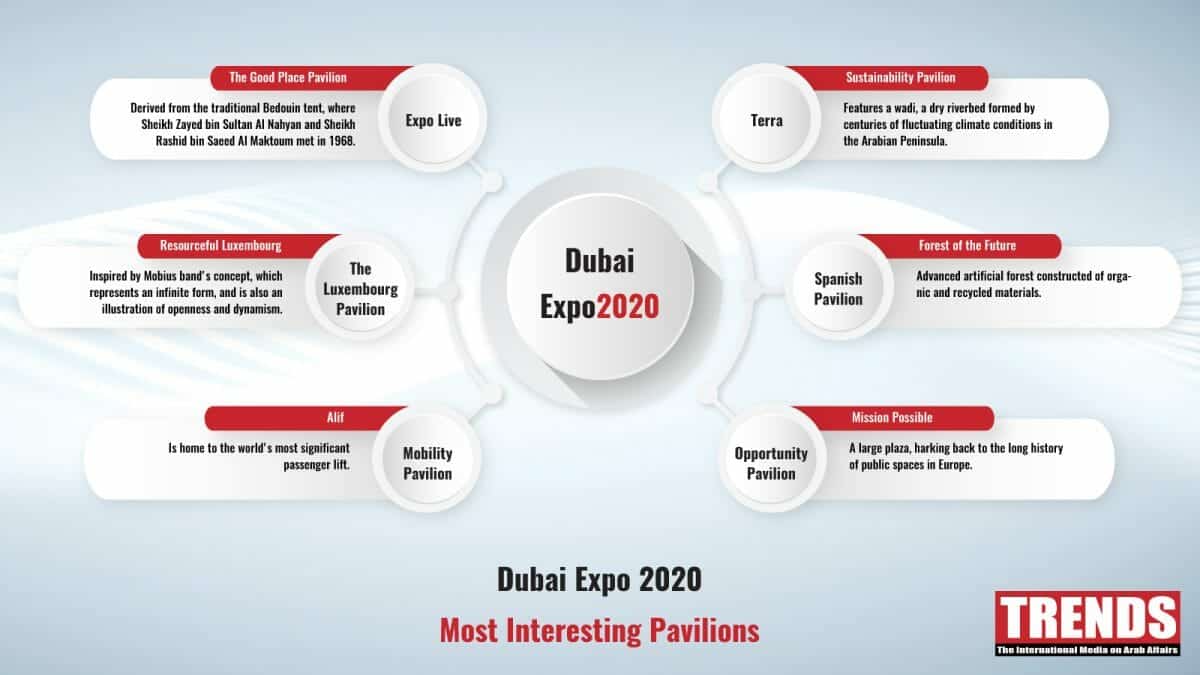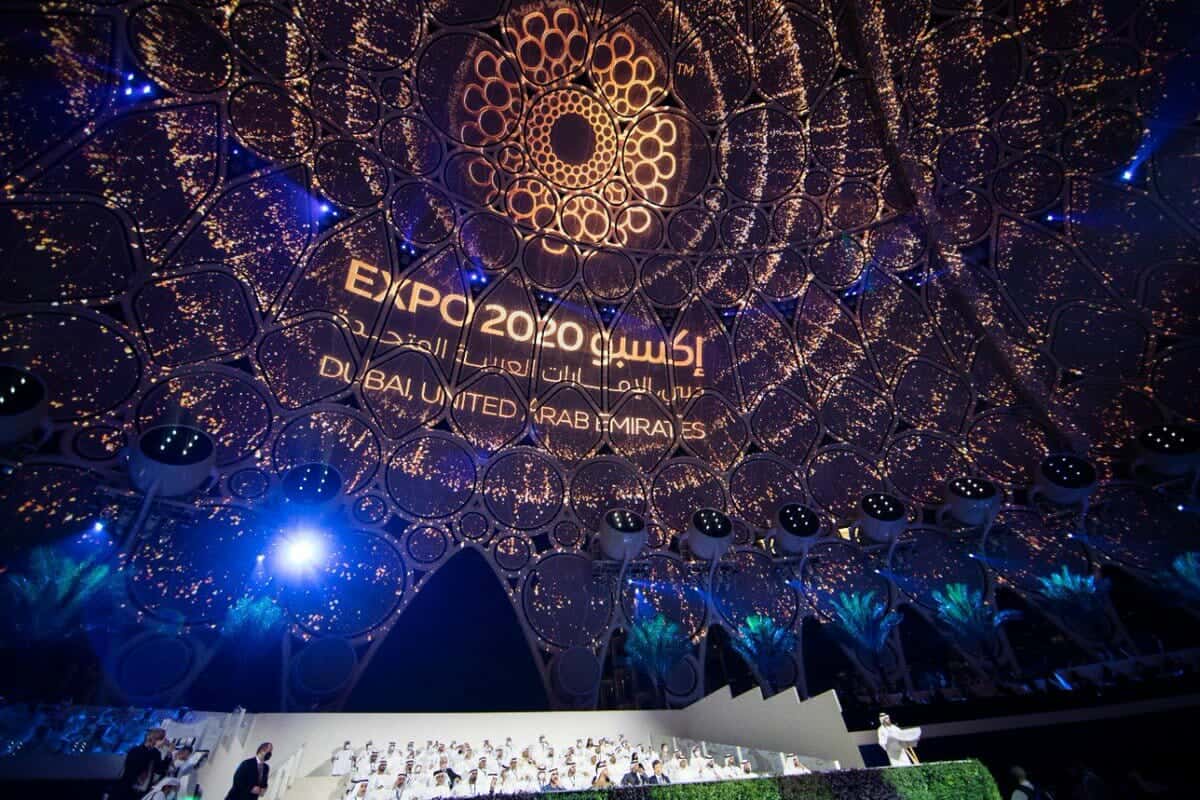Dubai is hoping for a positive 2021 fiscal, as economists anticipate a rise in profits due to various factors, one of which is Expo 2020. It is expected to contribute approximately 1.5 percent to the emirate’s GDP during the six months of its display.
Dubai plans to attract 25 million visitors by October via Expo 2020, and it has opened almost 90 percent of its airport capacity after the Covid-19 restrictions delayed the event for nearly a year.
These relaxed restrictions are allowing Emirates flights from India, Pakistan, Bangladesh, and Vietnam.
Serious precautions have also been taken to protect the workers and employees at Expo 2020.
All this, so that countries, sectors, and causes from all over the world may set up pavilions at this world fair.
Most Interesting Pavilions
Dubai Ruler Sheikh Mohammad Bin Rashid Al Maktoum has said 50,000 employees have made 192 pavilions for Expo 2020, while 30,000 volunteers are helping with the event.
Let’s look at Dubai Expo 2020s most interesting pavilions:
Good Place Pavilion – Expo Live
An earnest introductory cinematic is featured in the Good Place Pavilion as it introduces Expo Live, the characters, and how much it means to the world.
The Pavilion was designed by Ahmed Abdulrahman Bukhash, co-founder of the firm Archidentily.
The design concept was derived from the traditional Bedouin tent where Sheikh Zayed bin Sultan Al Nahyan and Sheikh Rashid bin Saeed Al Maktoum had an important meeting in 1968.
Sustainability Pavilion – Terra
The Sustainability Pavilion, designed by Grimshaw Architects, was set out to achieve LEED Platinum certification: the highest sustainability certification possible worldwide. This pavilion features a wadi: a dry riverbed formed by centuries of fluctuating climate conditions in the Arabian Peninsula.
Animals like elephants, ostriches, and cheetahs are all found in the sculptural and footprint exhibits.
In addition, this exhibit contains cultural artifacts representing the Bedouin who have lived in the desert for thousands of years.
With its 4,912 solar panels and 18 Energy Trees, Terra’s Sustainability Pavilion generates 4GWh of renewable energy annually, enough to charge over 900,000 mobile phones.
The Mobility Pavilion – Alif
This pavilion features nine-meter-tall historical mobility giants whose innovations aided in world navigation and laid the groundwork for the technology we use today.
It showcases a future where intelligent cities are created through artificial intelligence, big data, robotics, machine learning, and self-driving vehicles.
Visitors can also create their own robot or spaceship, attend workshops, and see performances inspired by technology.
The Mobility Pavilion, designed by Foster + Partners, is home to a passenger lift that is capable of transporting up to 160 people at a time.
Additionally, the pavilion features a 330-meter track that is partially underground and partly open-air, allowing visitors to observe cutting-edge mobility devices in action.
Resourceful Luxembourg
The design of the Luxembourg Pavilion was inspired by the concept of the Mobius strip, which represents an infinite form like circular economy, and is additionally an illustration of openness and dynamism.
The three-story building, designed by architecture firm Metaform, greets visitors with a loopy canopy that serves as the floor, walls, and ceiling all in one.
ArcelorMittal obtained its raw material by melting 170 tons of recycled scrap in the Belval and Differdange mills in Luxembourg.
The facade’s form is supported by steel pipes that form nearly 1,000 joints, with each link bending at a different angle.
After the Expo, this pavilion will become a part of District 2020, Dubai’s futuristic smart city.
After arrival, visitors are escorted through the halls to see the exhibit floor by floor, beginning with an ambulatory scenography that presents Luxembourg from five different perspectives: diverse, connecting, sustainable, enterprising, and beautiful.
This scene, developed by Jangled Nerves, details the lives of the people and all the things in the country, while also telling general information about the economy, the various sectors, and day-to-day life.

Spanish Pavilion – Forest of the Future
This technologically advanced forest is an artificial ecosystem constructed entirely of organic and recycled materials, in which future-ready Spanish companies are demonstrating their environmentally friendly products and services.
In the Spanish cities of Granada and Cordoba, remnants of Islamic architecture can still be found: a legacy of the Moorish rule over Andalusia that lasted for more than eight hundred years.
Spain’s participation in Expo 2020 Dubai is motivated by historical ties with the Arab world and global crises wreaking havoc on the planet.
Italian Pavilion
Rather than tossing away unwanted coffee beans and orange peels, the architects of the Italian Pavilion have used them in other ways, such as coating both inside and outside the pavilion with dried orange peels and ground coffee with a pinch of algae and a sprinkle of recycled plastic.
Those responsible for designing the pavilion envisioned a structure whose components would be composted or further recycled after the event.
According to Project Estimates, over 28,000 people should visit the Italy Pavilion every day, with more than 5 million people expected throughout the expo’s six-month duration.
Opportunity Pavilion – Mission Possible
The Opportunity Pavilion, designed by Kuwait-based and Madrid-based AGi Architects, showcases one of three key themes of Expo 2020 Dubai.
It is envisioned as a large plaza, alluding to the long history of public spaces in Europe — from ancient Greece and Rome to the present day — where people came together to converse and debate.
It aims to capture the belief that everything we do has a significant impact on individuals and communities.
The theme is also directly linked to the United Nations Sustainable Development Goals or SDGs.
Women’s Pavilion
The Women’s pavilion is intended to honor the significant roles that women — known and unknown — have played throughout history and continue to play today, on the principle that when women thrive, humanity thrives.
On the ground floor of the pavilion are five structures with distinct narratives: Introduction – defining the pavilion’s purpose; Achievements – shedding light on women’s impact on the world; Challenges – identifying the barriers that prevent women from thriving; Solutions – highlighting the initiatives that enable women to succeed so that humanity can thrive; and Engaging visitors – inspiring them to become advocates for gender equality and women’s empowerment and advancing the cause.
In addition to Lebanese actor and Oscar-nominated director Nadine Labaki, the pavilion was designed and curated by French interior architect Laura Gonzalez, Dubai-born artist Kholoud Sharafi, and a French light designer.

